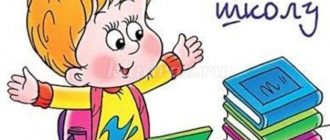Game technologies in speech therapy work article on speech therapy on the topic
MUNICIPAL BUDGETARY PRESCHOOL EDUCATIONAL INSTITUTION
KINDERGARTEN No. 6
general developmental type ___________________________________________________________________________________________________________________
143422, Moscow region, Krasnogorsky district, village. Petrovo-Dalnee, st. Sadovaya
tel/fax: 561-22-75
Prepared by speech therapist I.N. Smirnova
Explanatory note
A classification of educational technologies has been undertaken in the scientific literature. There are several approaches. Thus, one of the approaches to classifying educational technologies was taken by N.V. Bordovskaya and A.A. Rean. Scientists identify five types of educational technologies: task-based, gaming, computer, dialogue, and training technologies.
The concept of “game pedagogical technologies” includes a fairly extensive group of methods and techniques for organizing the pedagogical process in the form of various pedagogical games.
Unlike games in general, a pedagogical game has an essential feature - a clearly defined learning goal and a corresponding pedagogical result, which can be justified, identified explicitly and characterized by a cognitive orientation.
Gaming technologies are an integral part of pedagogical technologies. The problem of using gaming technologies in the educational process in pedagogical theory and practice is not new. L. S. Vygotsky, A. N. were engaged in the development of the theory of the game, its methodological foundations, clarification of its social nature, and its significance for the development of the student in Russian pedagogy. Leontyev, D.B. Elkonin et al.
Currently, gaming technologies are of great interest to teachers. More than once there has been an attempt to scientifically classify the game and define it in one comprehensive concept, but to date only the connections between the game and human culture have been scientifically determined, the significance that the game has on the development of the personality of a child and an adult has been clarified, and the biological nature of the game has been empirically identified. games and its conditioning by psychological and social factors. Meanwhile, gaming technologies remain “innovative” in the Russian education system.
Undoubtedly, both domestic and world pedagogical practice has accumulated baggage that can be used. This is, first of all, gaming technology. They have found wide application in our practice. Gaming technologies have enormous potential from the point of view of a priority educational task: the formation of a child’s subjective position in relation to his own activities, communication and himself.
The choice of gaming technology is justified by the fact that play is the leading activity of preschool children. Game motivation prevails over educational motivation, but on its basis readiness for learning at school is formed.
The purpose of using gaming technology in speech therapy practice is to increase motivation for classes, increase the effectiveness of correctional and developmental work, develop curiosity, and interest in the Russian language.
These goals led to the formulation and solution of tasks:
Study and analyze literature on the topic.
To study the features of using gaming technology in speech therapy work.
Create an office passport with a list of printed board games and aids.
Select teaching aids on the topic of gaming activities in speech therapy practice.
Constantly update and expand the card index of word games.
Select toys for speech therapy work.
Develop lesson notes in a playful way.
Provide methodological assistance to educators in conducting preventive work using games.
Provide advisory assistance to parents on conducting classes in a playful way when performing speech therapist tasks.
Expected results:
Increasing motivation for speech therapy sessions.
Increasing the effectiveness of correctional and developmental work.
Improving performance in sound pronunciation classes and preparing for literacy.
A selection of gaming material: didactic toys, games, educational aids for correctional work.
Development of the necessary visual aids for conducting individual and subgroup lessons in a playful way.
Development of consultations for parents and teachers on the topic of using different types of games for speech development.
Development of lesson notes in a playful way with children of the older group (studying at the speech center) on the formation of the phonemic aspect of speech and preparation for learning to read and write, enriching and activating the vocabulary, and developing the skill of coherent utterance.
Adapted lesson notes for children of the preparatory group (studying at the speech center) S.P. Tsukanova, L.L. Betz on the development of the phonemic aspect of speech and teaching literacy to children of senior preschool age.
A selection of gaming materials for working with “non-speaking” children.
Development of aids for performing articulation and breathing exercises in a playful manner.
A selection of gaming aids and didactic games for the development of psychological speech skills.
Media library of licensed computer programs and games, game educational presentations for speech therapy work.
music library for performing logorhythmic exercises and finger gymnastics.
Using gaming technology in speech therapy work
To carry out correctional and developmental work using gaming technologies, toys, didactic and computer games were selected at the speech therapy center.
Using toys
Toys are used in classes as heroes that create motivation, a playful situation and a surprise moment. Almost every subgroup lesson in the senior group “has a guest.” This could be the dinosaur Zvukhoozhka, the bear Umka who can play the drum, a donkey playing the balalaika, a doll that tells children about parts of the body, a little squirrel who is looking for friends, an old man and an old woman from a fairy tale, etc. Almost always, these toys immerse children in some kind of - a fairy-tale or game situation where children must help the heroes or invite them to play, teach them what the children themselves are learning. At the end of the session they thank them for their help. This game situation cultivates the moral feelings of children; they not only learned to pronounce a sound, but also helped Umka learn his favorite sound U, etc.
Role-playing games are used to work with children of primary preschool age with developmental disabilities and level 1 or 2 ODD. To evoke verbal responses in a non-speaking child, some kind of story is played out with several toys and the child is involved in a role-playing game. In this way, short dialogues are practiced, which can consist of onomatopoeia and simple words, and you can repeat the newly appeared word repeatedly using it in a game situation.
One of my favorite toys is a ball. It is used for dynamic breaks and didactic games. And hedgehog balls are also for hand massage.
Game form of classes
The game form of classes is created by game motivation, which acts as a means of inducing and stimulating children to educational activities. The implementation of gaming techniques and situations in the classroom takes place in the following main areas:
a didactic goal is set for children in the form of a game task;
educational activities are subject to the rules of the game;
educational material is used as its means;
an element of competition is introduced into educational activities, which transforms a didactic task into a game one;
successful completion of a didactic task is associated with the game result.
Speech therapy classes are held in a playful way. At the beginning of the lesson, a didactic task is set in a playful form. For example: a guest appears, a letter arrives with a task for children, or an immersion in a fairy tale. During the lesson, by performing exercises on the instructions of the hero. Children can also play roles (athletes, travelers, astronauts, passengers, etc.). For successful completion of tasks, children can be assessed with chips, stars, etc., which introduces a competitive element.
Older preschoolers really like activities in the form of competitions, quizzes, and competitions. But in this case, the speech therapist needs to think carefully about assigning children to teams or selecting children to perform various activities, so that the child feels comfortable in the lesson, does not withdraw, and does not hesitate to take part in the competition. It is necessary to create a friendly atmosphere in the group, in the team, so that children support each other, act together, amicably.
Workbooks are used for individual and subgroup lessons. In the older group - notebooks by N.E. Teremkova, in preparatory school - S.P. Betz, L.L. Tsukana “I am learning to speak and read.” Children really like the entertaining stories proposed by the authors of the manuals. Each notebook has permanent characters who support the game plot throughout the entire learning period.
Subgroup speech therapy classes in preparation for learning to read and write are conducted in senior and preparatory school groups. To facilitate the assimilation of educational material, several didactic aids have been produced. In the office there are castles of sounds, in which girls gradually settle in - vowel sounds and boys - consonant sounds. To indicate the stages of the lesson, the sequence of exercises, tasks, a manual “Path of Tests” was prepared.
To attract the child’s attention to articulatory gymnastics, drawings for the speech therapist’s story “Tales of a Merry Tongue” and gymnastics with Smeshariki are used.
Didactic games
Particular mention should be made of didactic games, which are created and organized by adults and are aimed at developing certain qualities of the child. These games are widely used in kindergartens as a means of teaching and educating preschoolers. A child is attracted to a game not by the educational task inherent in it, but by the opportunity to be active, perform game actions, achieve results, and win. However, if a participant in the game does not master the knowledge and mental operations that are determined by the learning task, he will not be able to successfully perform game actions or achieve results.
Didactic games with objects are very diverse in terms of game materials, content, and organization. The following teaching materials are used:
• toys,
• real objects (household items, tools, works of decorative and applied art, etc.,
• objects of nature (vegetables, fruits, cones, leaves, seeds).
Games with objects make it possible to solve various educational problems:
• Expand and clarify children’s knowledge,
• Develop mental operations (analysis, synthesis, comparison, discrimination, generalization, classification),
• Improve speech,
• Develop all mental processes.
Among games with objects, a special place is occupied by plot-didactic games and dramatization games, in which children play certain roles, for example, a seller, a buyer in games like “Shop”. In such games, patience, perseverance, intelligence are cultivated, and the ability to navigate in space is developed.
. Printed board games, which are now widespread, are also games with rules. All of these games are usually competitive in nature: unlike role-playing games, there are winners and losers. The main goal of such games is to strictly follow the rules, so they require a high degree of voluntary behavior and, in turn, shape it. Such games are typical mainly for older preschoolers.
Printed board games are varied in content, educational tasks, and design. They help clarify and expand children’s ideas about the world around them, systematize knowledge, and develop thought processes. Types of printed board games: lotto, dominoes, labyrinth, cut pictures, puzzles, cubes, etc.
Verbal games are distinguished by the fact that the process of solving a learning task is carried out mentally, based on ideas and without relying on visualization. Therefore, word games are carried out mainly with children of middle and senior preschool age. Among these games there are many folk games associated with nursery rhymes, jokes, riddles, shapeshifters, riddle games (“What time of year is this?”, guessing games (“What would happen if.?”).
The didactic game has its own structure, which includes several components. The main component is the didactic (learning) task. Play actions are ways of demonstrating a child’s activity for play purposes. Rules – ensure the implementation of game content. They make the game democratic - all participants in the game obey them.
There is a close connection between the learning task, game actions and rules. The learning task determines the game actions, and the rules help to carry out the game actions and solve the problem.
Didactic games are used in classes and in children’s independent activities. Being an effective teaching tool, they can be an integral part of the lesson, and in early age groups - the main form of organizing the educational process.
Didactic games are widely used in correctional and developmental work with children with speech impairments. For each area of work, games have been selected to solve a narrow correction problem. Much attention is paid to the “Sound Pronunciation” section, because When carrying out work on automation, differentiation of sound and its introduction into speech, the work should be varied and not bore the child. Game motivation stimulates interest in a positive result. On the other hand, gaming motivation can also serve as a complication when consolidating the skill of correct pronunciation, because Having become carried away by the game plot, the child ceases to control pronunciation and may lose. Therefore, he has to concentrate on two tasks at the same time: following the rules of the game and monitoring the correct pronunciation. Some games, such as “Electronic Quiz”, “Logical Kid”, allow the child to independently control the correctness of the task.
With the help of didactic games, work is carried out to consolidate the skills of inflection, word formation, and coherent speech. When it is necessary to consolidate acquired skills, children can choose a game on their own, using the symbolic designation of games.
The most favorite games for children to develop the psychological basis of speech. Games such as “What’s missing?”, “What’s changed?”, “Remember and name”, “Wonderful bag”, etc., are used in correcting sound pronunciation, syllable structure, and activating the dictionary.
The office has printed board games that are used with children of different ages in different areas of speech therapy work. Some games have been adapted for working with children with speech disorders.
The office is equipped with a computer, which makes it possible to use ICT in speech therapy work. We independently developed 3 game presentations “Sound C”, “Sounds S-Z”, “Merry Talkers”. In order to develop breathing, a sense of rhythm, phonemic hearing, perception, pronunciation, coherent speech, and grammatical structure, the speech therapy programs “Games for Tigers” and “Learning to Speak Correctly” are used.
Consultations are held annually for educators and parents on the use of games in correctional work. Tips and recommendations are posted on the kindergarten website and the speech therapy center website.
The urgent task of preschool education is to prepare children for school, comprehensive mental and intellectual development. For preschool children with speech impairments, special speech therapy groups are created in kindergartens, the main task of which is the correction of speech defects. To solve this problem, special programs are being implemented within the kindergarten. Among the methods for correcting speech therapy disorders in preschoolers, play therapy methods have proven themselves to be more effective in terms of effectiveness. It is during the game that the system of relationships between the preschooler and the outside world is built, and mental functions develop, among which speech occupies the main place. The use of gaming technologies in speech therapy work with children helps to prevent or repress or fixate the child on his defect. The child, freely expressing his thoughts and feelings, develops speech skills in the game.
Preschool game:
- encourages children to communicate with each other;
helps to consolidate the skills of using initiative speech;
- contributes to the improvement of spoken language;
- helps to enrich the vocabulary;
- influences the formation of the grammatical structure of the language.
Therefore, the need for serious correctional plans of the speech therapist in his work through play is obvious. The work of a speech therapist requires the use of gaming techniques to an even greater extent than in conventional educational activities.
A didactic game is one of the forms of educational influence of teachers on a child. At the same time, play is the main activity of children. Thus, the game realizes educational (which the teacher pursues) and gaming (for which the child acts) goals. It is important that these two goals complement each other and ensure the assimilation of program material. A didactic game is a valuable means of cultivating mental activity; it activates mental processes and arouses a keen interest in the process of cognition in preschoolers. The game helps to make any educational material exciting, causes deep satisfaction in children, stimulates performance, and facilitates the process of assimilation of knowledge. A.V. Zaporozhets, assessing the role of the didactic game, emphasized: “We need to ensure that the didactic game is not only a form of assimilation of individual knowledge and skills, but also contributes to the overall development of the child.”
The following types of didactic games can be distinguished:
Travel games are designed to enhance the impression and draw children’s attention to what is nearby. They sharpen observation and demonstrate overcoming difficulties. These games use many ways to reveal cognitive content in combination with gaming activities: setting problems, explaining how to solve them, solving problems step by step, etc.
Games - instructions are simpler in content and shorter in duration. They are based on actions with objects, toys, and verbal instructions.
Games are speculation (“what would happen if…”). Children are given a task and a situation is created that requires comprehension of the subsequent action. At the same time, children’s mental activity is activated, they learn to listen to each other.
Games are riddles. They are based on testing knowledge and resourcefulness. Solving riddles develops the ability to analyze, generalize, and develops the ability to reason and draw conclusions.
Games - conversations. They are based on communication. The main thing is spontaneity of experience, interest, and goodwill. Such a game makes demands on the activation of emotional and mental processes. It develops the ability to listen to questions and answers, focus on the content, supplement what is said, and express judgments. Cognitive material for this type of games should be given in an optimal volume, be accessible and understandable in order to arouse the interest of children. Cognitive material is determined by the lexical topic and the content of the game. The game, in turn, must correspond to the mental capabilities of children.
The didactic game has a certain structure.
Structure is the main elements that characterize the game as a form of learning and gaming activity at the same time.
The following structural components of the didactic game are distinguished:
- didactic task;
- game task;
- game actions;
- rules of the game;
- result (summarizing).
The didactic task is determined by the purpose of the teaching and educational impact. It is formed by the teacher and reflects his teaching activities. For example, in a number of didactic games, knowledge, skills, and abilities are consolidated in accordance with program objectives. The game task is carried out by children. The didactic task in a didactic game is realized through a game task.
The game task determines the game actions and becomes the task of the child himself. The most important thing: the didactic task in the game is deliberately disguised and appears before the children in the form of a game plan (task).
Game actions are the basis of the game. The more varied the game activities, the more interesting the game itself is for children and the more successfully cognitive and gaming tasks are solved. In different games, game actions differ in their focus and in relation to the players. This, for example, could be role-playing activities, solving riddles, spatial transformations, etc. they are related to and derived from the game design. Game actions are means of realizing the game plan, but also include actions aimed at fulfilling the didactic task.
Rules of the game. Their content and focus are determined by the general tasks of forming the child’s personality, cognitive content, game tasks and game actions. The rules contain moral requirements for the relationships between children and for their compliance with norms of behavior. In a didactic game, the rules are given. With the help of rules, the teacher controls the game, the processes of cognitive activity, and the behavior of children. The rules also influence the solution of the didactic task - they imperceptibly limit the actions of children and direct their attention to implementation.
In modern speech therapy, a didactic game is created by a teacher specifically for educational purposes, when learning proceeds on the basis of a gaming and didactic task. In didactic play, the child not only gains new knowledge, but also generalizes and consolidates it. A didactic game acts simultaneously as a type of play activity and a form of organizing interaction between a speech therapist and a child. This is where its originality lies.
Thus, the use of didactic games in the work of a speech therapist contributes to the development of children’s speech activity and to increasing the effectiveness of correctional work. It must be remembered that the development of speech in preschoolers during play activities is an attempt to teach children lightly, joyfully, without coercion.
MAGAZINE Preschooler.RF
The use of gaming technologies in the work of a speech therapist teacherMBDOU No. 22 “Blue Bird” Teacher – speech therapist Dunaeva N.S.
Modern Speech Therapy is in a constant active search for ways to improve and optimize the process of learning and development of children at different age stages and in various educational conditions that are typical for children with special educational needs.
Modern speech therapy practice has in its arsenal technologies aimed at timely diagnosis and the maximum possible correction of speech disorders.
These include well-known technologies:
- Technology of speech therapy examination.
- Sound pronunciation correction technology.
- Technology for the formation of speech breathing in various disorders of the pronunciation aspect of speech.
- Voice correction technology for various pronunciation disorders of speech.
- Technology for the development of intonation aspects of speech.
- Technology for correcting the tempo-rhythmic aspect of speech.
- Technology for the development of the lexical and grammatical aspects of speech.
- Speech therapy massage technology.
In my work, I widely use gaming technologies. To make an activity with children interesting, but not entertaining, effective, but not showy, to teach by playing, and not just playing - these are the main problems that a speech therapist needs to solve when working with children.
The purpose of this technology is aimed at developing the following skills:
- imagination
- attention
- memory
- speeches
- thinking
- comparison skills
- compare
- find analogies.
I use the following types of games:
- Didactic
- Role-playing games
- Verbal
- Games for the development of mental processes
- Phonemic hearing and sound analysis
- Syllable structure for teaching literacy.
As a result of our work, we will achieve the following results:
- Increased cognitive activity
- formation of motivation for educational activities
- Improved speech, etc. d
The use of computer games and programs can be another effective way to form correct speech and correct its shortcomings.
The software and didactic complex “Logomer 2” is a fundamentally new product on the Russian educational market. This innovation in the correctional process immediately gave positive results in working on sound pronunciation, lexico-grammatical structure of speech, coherent speech and in teaching elements of literacy, that is, in all areas of the work of a speech therapist. This made it possible to work on the processes of higher mental activity: memory, attention, thinking. The children's desire to study effectively increased.
Game tasks are aimed at developing auditory perception skills of correct pronunciation of sounds of the native language, syllables, words and the ability to speak coherently, independently construct phrases and sentences. While playing, the child expands his knowledge of the surrounding reality, increases his vocabulary, develops visual and logical thinking, visual and auditory memory, and intelligence.
Educational games include the following sections:
- Breathing, air stream (8 games)
- Phonemic hearing, sound-letter analysis (12 games)
- Non-speech hearing (7 games)
- Onomatopoeia (4 games)
- Grammar structure (6 games)
- Syllable structure of the word (5 games)
- Sound pronunciation (16 games)
- Connected speech (6 games)
- Motor skills (3 games)
- Logic and attention (9 games)
- Vocabulary (13 games)
To conduct classes with children, I select tasks according to the degree of difficulty appropriate to the age and development of the child.
Program features:
speech development and correction;
all stages of speech development: recognition of the sounds of the surrounding world, learning to correctly pronounce the sounds of the Russian language, development of coherent speech;
colorful graphics, many sound files;
several levels of difficulty in each task for children with different levels of speech and hearing development;
The choice of gaming technology is justified by the fact that play is the leading activity of preschool children. Game motivation prevails over educational motivation, but on its basis readiness for learning at school is formed.
| Next > |





